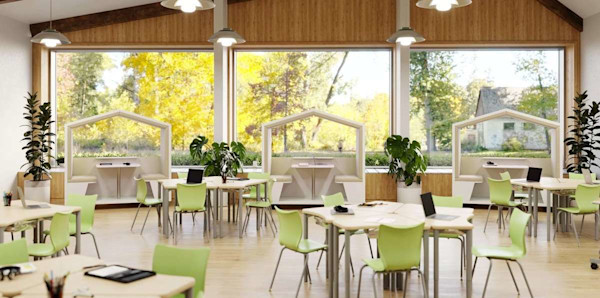Hybrid and Smart: Building a Workplace of the Future

The workplace is constantly evolving. From scheduling to technology, the introduction of new business models is the driving force behind the workplace of the future. The hybrid model is creating a need for flex space, specialized software for scheduling, and resources that streamline communication processes. With the development of technology and time-proven business models, smart workplaces are becoming more and more common. It is no secret that remote and hybrid business models come with their fair share of unique hurdles. Office design, platforms that log performance, and task management software are just a few of the resources used to ensure quality work from anywhere as we imagine the workplace of the future.
The Smart Workplace

Creating Flexible Workspaces

Remote But Not Forgotten

In any area where collaboration will be taking place, include monitors to bring offsite workers into the interactions.
If you worked remotely at all during the pandemic, you are aware that video calls were the main source of connection. Even before the pandemic, many businesses used video calling or conferencing for collaborative projects, one one-on-one meetings, or to watch presentations and training. The ability to see and interact with coworkers or employees during these interactions helps maintain a connection. In any area where collaboration will be taking place, include monitors to bring offsite workers into the interactions. No matter where your team is working from, it is important to directly engage with them. To see their faces to really surmise how they are feeling. These interactions help maintain connections. Connection and community are essential to retaining employees, which all businesses have top of mind. Technology makes it easier to work offsite while creating a more enjoyable work experience. For those who miss in person interactions, technology can help bridge the gap.
Smart Break Rooms

In our hybrid reality, engagement, efficiency, and productivity would not be possible without technology.
Quiet areas allow employees to separate themselves from their desks, coworkers, and their work. Whether quiet areas are used to take care of personal business on breaks or if employees need to take time to regroup before returning to work, having a private area that employees can use completely for themselves is important. A smart break room can include everything from personal climate-controlled areas, to remotely monitored inventory levels to make sure you never run out of team favorite snacks. And of course, monitors! These screens are important to include in meeting and collaboration areas, but be sure to include them in the break room too.
Change for Good in the Workplace of the Future




